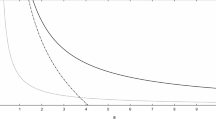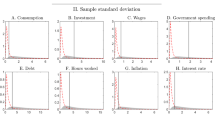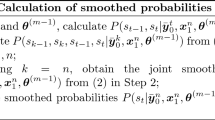Abstract
A new Markov switching asymmetric GARCH model is proposed where each state follows the smooth transition GARCH model, represented by Lubrano (Recherches Economiques de Louvain 67:257–287, 2001), that follows a logistic smooth transition structure between effects of positive and negative shocks. This consideration provides better forecasts than GARCH, Markov switching GARCH and smooth transition GARCH models, in many financial time series. The asymptotic finiteness of the second moment is investigated. The parameters of the model are estimated by applying MCMC methods through Gibbs and griddy Gibbs sampling. Applying the log return of some part of \( S \& P\ 500\) indices, we show the competing performance of in sample fit and out of sample forecast volatility and value at risk of the proposed model. The Diebold–Mariano test shows that the presented model outperforms all competing models in forecast volatility.





Similar content being viewed by others
Notes
log return in percentage is defined as \(r_t=100*\log \Big (\frac{P_t}{P_{t-1}}\Big )\), where \(P_t\) is the index level at time t.
References
Abramson A, Cohen I (2007) On the stationarity of Markov-Switching GARCH processes. Econom Theory 23:485–500
Alemohammad N, Rezakhah S, Alizadeh SH (2016) Markov switching component GARCH model: stability and forecasting. Commun Stat Theory Methods 45(15):4332–4348
Ardia D (2008) Financial risk management with Bayesian estimation of GARCH models: theory and applications, vol 612. Lecture notes in economics and mathematical systems. Springer, Heidelberg
Ardia D (2009) Bayesian estimation of a Markov switching threshold asymmetric GARCH model with Student-t innovations. Econom J 12(2):105–126
Bauwens L, Lubrano M (1998) Bayesian inference on GARCH models using the Gibbs sampler. Econom J 1:23–46
Bauwens L, Storti G (2009) A component GARCH model with time varying weights. Stud Nonlinear Dyn Econom 13:Article 1
Bauwens L, Preminger A, Rombouts VK (2010) Theory and inference for a Markov switching GARCH model. Econom J 13:218–244
Berg A, Meyer R, Yu J (2004) Deviance information criterion for comparing stochastic volatility models. J Bus Econ Stat 22:107–120
Black F (1976) studies of stock price volatility changes. In: Proceedings of the 1976 meetings of the business and economic statistics section. American Statistical Association, Washington DC, pp 177–181
Bollerslev T (1986) Generalized autoregressive conditional heteroscedasticity. J Econom 31:307–327
Chib S (1996) Calculating posterior distributions and model estimates in Markov mixture models. J Econom 75:79–97
Christofferssen P (1998) Evaluating interval forecasting. Int Econ Rev 39:841–862
Curto JD, Pinto JC (2012) Predicting the financial crisis volatility. Econ Comput Econ Cybern Stud Res J 46:183–195
Curto JD, Pinto JC, Tavares GN (2009) Modeling stock markets volatility using GARCH models with Normal, Students t and stable Paretian distributions. Stat Pap 50:311–321
Diebold FX, Mariano RS (1995) Comparing predictive accuracy. J Bus Econ Stat 13:253–263
Engle RF (1982) Autoregressive conditional heteroscedasticity with estimates of the variance of United Kingdom inflation. Econometrica 50:987–1007
Engle RF (1990) Discusion: stock volatility and the crash of ’87. Rev Financ Stud 3:103–106
Gelman A, Hwang J, Vehtari A (2014) Understanding predictive information criteria for Bayesian. Stat Comput 24:997–1016
Glosten LR, Jagannathan R, Runkle D (1993) On the relation between the expected value and the volatility of the nominal excess return on stocks. J Financ 48:1779–1801
Gonzalez-Rivera G (1998) Smooth transition GARCH models. Stud Nonlinear Dyn Econom 3:61–78
Gray SF (1996) Modeling the conditional distribution of interest rates as a regime-switching process. J Financ Econ 42:27–62
Haas M, Mittnik J, Paolella MS (2004) A new approach to markov-switching GARCH models. J Financ Econom 2:493–530
Haas M, Krause J, Paolella MS, Steudc SC (2013) Time varying mixture GARCH models and asymmetric volatility. N A J Econ Financ 26:602–623
Hamilton JD, Susmel R (1994) Autoregressive conditional heteroskedasticity and changes in regime. J Econom 64:307–333
Harvey D, Leybourns S, Newbold P (1997) Testing the equality of prediction mean squared error. Int J Forecast 13:281–291
Kaufman S, Fruhwirth-Schnatter S (2002) Bayesian analysis of switching ARCH models. J Time Ser Anal 23:425–458
Klaassen F (2002) Improving GARCH volatility forecasts with regime-switching GARCH. Empir Econ 27:363–394
Lancaster P, Tismenetsky M (1985) The theory of matrices, 2nd edn. Academic Press, New York
Liu S, Heyde CC, Wong WK (2008) On estimation in conditional heteroskedastic time series models under non-normal distributions. Stat Pap 49:455–469
Lubrano M (2001) Smooth transition GARCH models: a Bayesian approach mixture models. Recherches Economiques de Louvain 67:257–287
Medeiros MC, Veiga A (2009) Modeling multiple regimes in financial volatility with a flexible coefficient GARCH(1,1). Econom Theory 25:117–161
Miazhynskia T, Dorffner G (2006) A comparison of Bayesian model selection based on MCMC with an application to GARCH-type models. Stat Pap 47:525–549
Nelson DB (1991) Conditional heteroskedasticity in asset returns: a new approach. Econometrica 59:347–370
Ritter C, Tanner MA (1992) Facilitating the Gibbs sampler: the Gibbs Stopper and the Griddy-Gibbs Sampler. J Am Stat Assoc 87:861–868
Speigelhalter DJ, Best NG, Carlin BP, Van del lindle A (2002) Bayesian measures of model complexity and fit. J R Stat Soc Ser 64:583–639
StataCrop (2015) Stata: release 14 Statistical software. StataCrop LLC, College station
Xekalaki E, Stavros D (2010) ARCH nodels for financial applications. Wiley, New York
Zakoian JM (1994) Threshold heteroskedastic models. J Econ Dyn Control 27:577–597
Acknowledgements
This paper initiated during Professor Rezakhah sabbatical at Institute of Mathematics at the EPFL where benefited from the discussion of the paper with Professor Stephan Morgenthaler and careful written comments and suggestions of Professor Anthony Davison which caused to improve the quality of this paper.
Author information
Authors and Affiliations
Corresponding author
Appendices
Appendix A
Proof of Lemma 3.1
As the hidden variables \(\{Z_{t}\}_{t\ge 1}\) have Markov structure in MS-STARCH model, so
\(\square \)
Appendix B
Proof of Theorem 3.1
Let \(E_{t}(.)\) denotes the expectation with respect to the information up to time t. Thus the second moment of the model can be calculated as, see Abramson and Cohen (2007):
Also let \(E(.|z_t)\) and \(p(.|z_t)\) denote \(E(.|Z_t=z_t)\) and \(P(.|Z_t=z_t)\), respectively, where \(z_t\) is the realization of the state at time t. Applying to the method of Medeiros and Veiga (2009), we find an upper bound of \(E_{t-1}(H_{m,t}|z_t)\), for \( m=1,2,\ldots ,K\) by the following
The term (II) in (7.3) can be interpreted as follows:
where \(S_{{\mathcal {I}}_{t-1}}\) is the support of \({\mathcal {I}}_{t-1}=(y_1,\ldots ,y_{t-1})\). \(\square \)
Upper bound for III in (7.3): Let \(0<M<\infty \) be a constant, so
in which
As by (2.4), \(0<w_{m,t-1}<1\) and so
also
by (2.4),
So for any fixed positive small number \(\delta >0\), we can consider \(M>0\) so large that for \(y_{t-1}\ge M\), \(|w_{m,t-1}-1|\le \delta \) and for \(y_{t-1}\le -M\), \(|w_{m,t-1}|\le \delta \). Hence
Since the distribution of the \(\{\varepsilon _{t}\}\) is symmetric, then
and
Therefore
Upper bound for IV in (7.3):
By replacing the obtained upper bounds and relations (7.4) in (7.3), the upper bound for \(E_{t-1}(H_{m,t}|z_t)\) is obtained by:
in which by Bayes’ rule
where P is the transition probability matrix.
Let \(A_t(j,k)=E_{t-1}[H_{j,t}|Z_{t}=k]\), \( {A}_t=[A_t(1,1),A_t(2,1),\ldots ,A_t(K,1),A_t(1,2),\ldots ,A_t(K,K)]\) be a \(K^2\)-by-1 vector and consider \(\dot{ { {\Omega }}}=( { {\Omega }}^{\prime },\ldots , { {\Omega }}^{\prime })^{\prime }\) be a vector that is made of K vector \({ {\Omega }}\). By (7.23)–(7.26), the following recursive inequality is attained,
with some initial conditions \(\mathbf{A }_{-1}.\) The relation (7.8) implies that
Following the matrix convergence theorem Lancaster and Tismenetsky (1985), the necessary condition for the convergence of \( {B}_{t}\) when \(t\rightarrow \infty \) is that \(\rho ({ {C}}) <1\). Under this condition, \({ {C}}^t\) converges to zero as t goes to infinity and \(\sum _{i=0}^{t-1}{{ {C}}^i}\) converges to \((I-{ {C}})^{-1}\) provided that matrix \((I-{ {C}})\) is invertible. So if \(\rho ({ {C}}) <1\),
By (7.2) the upper bound for the asymptotic behavior of unconditional variance is given by
Rights and permissions
About this article
Cite this article
Alemohammad, N., Rezakhah, S. & Alizadeh, S.H. Markov switching asymmetric GARCH model: stability and forecasting. Stat Papers 61, 1309–1333 (2020). https://doi.org/10.1007/s00362-018-0992-2
Received:
Revised:
Published:
Issue Date:
DOI: https://doi.org/10.1007/s00362-018-0992-2




